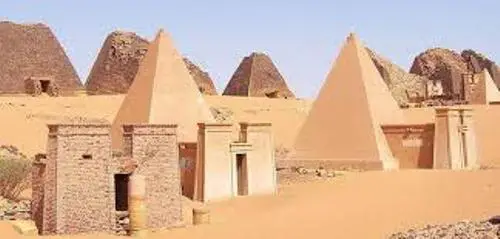Nubia is known as “Land of Gold” to Egypt. It is the stretch of land next to the Nile river from Aswan down to Khartoum in the south. It was the homeland to Africa’s earliest kingdoms and oldest cultures. Nubian history goes back from 3100 BC onward through written records from Ancient Egypt and Rome as well as Nubian monuments and artifacts. In many tomb paintings and reliefs, Nubians are usually depicted as mercenaries or traders. Ancient Egypt and Nubia facts from the past finds in the area suggest that Qustul in Nubia could well have been the seat of Egypt’s founding dynasty.

Nubian civilization was first called as Ta-Seti, which means “Land of the Bow” named for its famous archers. These archers provided military strength due to their exceptional skills to the Nubian kings. The Kings of Nubia were ultimately able to conquer and rule Egypt for about a century. Nubian rulers built cities, temples, and royal pyramids in modern Egypt and Sudan. This is evident from the artifacts and monuments that still stand at the sites.
Ancient Egypt and Nubia Facts Trade
The Nubian population was often a diverse mix of African peoples as African people began to move toward the Nile in Nubia by around 5000 BC. Originally, these people were herdsmen and hunters of large animals but eventually, they became fishermen and farmers. These Africans brought with them the art of making pottery.

The Nubian farmers grew grains, lentils, dates, peas and possibly melons. But important were their herds of cattle which were a measure of their social status and wealth. Due to the abundance of gold and other mineral resources, the Nubians mined carnelian and gold in the deserts. They traded with their neighbors to the north, the Egyptians, for grain, wine, beer, vegetable oils, linen, and other manufactured goods. Bartering cattle, gold, carnelian, ivory, hardwood, animal skins, dates and incense were traded heavily. It was for the precious metal gold that Nubian trade relationship with the Egyptians was some uneasy type, sometimes allies and sometimes wretched enemies.
Though due to the construction of a dam at Aswan in Egypt, ancient temples, tombs as well as hundreds of modern villages in Nubia were permanently flooded. Nubians still have distinct traditions, architecture, and languages, even though many have either migrated to Aswan and Kom Ombo or to the south towards Sudan.
The Kingdom of Kush
During the time of Egypt’s Old and Middle Kingdoms (ca. 2686 B.C. – 1650 BC), the Kingdom of Kush was already in existence. However, the Kingdom of Kush rose to power during the Second Intermediate Period, as Lower Egypt fell to the Hyksos at the end of the Middle Kingdom. The Kingdom of Kush came to be the dominant power in Upper Egypt.
In the mid-16 Th century BC, with the emergence of the 18 Th Dynasty and its rulers, Egypt was able to present a united front expelling the Hyksos, and making Nubia became an Egyptian colony under the rule resulting in the ending of the Kingdom of Kush. The Kingdom of Kush was centered at Napata, in modern central Sudan during its early days. The 25 Th Dynasty of the Kushite Kingdom was established by the Kushite king, Piye, as a result of Division and internal political instability in Lower Egypt. However, the Kushite rule in Egypt would last for less than a century.
The Kushites were initially on peaceful terms with Assyria, but due to the expansion of the Neo-Assyrian Empire in the Near East and the Egyptian support for an anti-Assyrian coalition sparked hostilities. In 671 BC, the Kushite Dynasty of Egypt came to an end as Egypt was invaded by the Assyrians. However, the records of writers from the Roman period show that the Kingdom of Kush still continued to survive in Nubia. The frequent raids of the nomads and the eventual emerging Kingdom of Axum in Ethiopia were the reasons that marked the end of Kingdom of Kush as the Kushite capital of Meroe was captured and burnt to the ground.